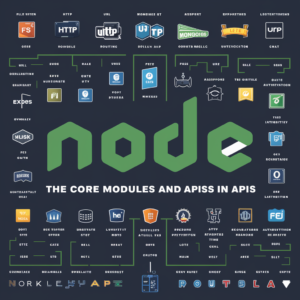Node.js is known for its unique and efficient architecture that makes it a popular choice for building scalable and high-performance applications. In this chapter, we’ll explore the key aspects of Node.js architecture, including event-driven programming, the event loop and non-blocking I/O, and the Node.js module system.
Event-Driven Programming
Event-driven programming is a programming paradigm where the flow of the program is determined by events, such as user actions, sensor outputs, or messages from other programs. In Node.js, this approach is central to how the platform operates.
How Event-Driven Programming Works in Node.js:
- Events and Callbacks: Node.js is built around an event-driven architecture, where events are emitted and event listeners (or callbacks) respond to those events. For example, when a server receives a request, it triggers an event, and the corresponding callback function handles the request.
- Efficiency: This model allows Node.js to handle multiple connections concurrently. Instead of waiting for a task to complete, Node.js continues to process other events, making it highly efficient for I/O-bound tasks.
Example: Here’s a simple example to illustrate event-driven programming in Node.js:
const EventEmitter = require('events');
const eventEmitter = new EventEmitter();
// Event listener for the 'greet' event
eventEmitter.on('greet', () => {
console.log('Hello, Node.js!');
});
// Emit the 'greet' event
eventEmitter.emit('greet');
In this code, we create an event listener for a custom event called ‘greet’, and when we emit this event, the listener executes the callback, printing “Hello, Node.js!” to the console.
The Event Loop and Non-Blocking I/O
The event loop is a core component of Node.js architecture that enables non-blocking I/O operations, allowing the platform to perform efficiently under heavy loads.
Understanding the Event Loop:
- Single-Threaded: Node.js operates on a single-threaded event loop, which might seem limiting at first. However, this event loop is responsible for handling all asynchronous operations in the application.
- Handling Operations: When a task, such as reading a file or querying a database, is initiated, Node.js registers the operation and then moves on to handle other tasks. Once the operation is complete, the event loop picks up the result and triggers the corresponding callback.
- Non-Blocking I/O: This design ensures that I/O operations do not block the execution of other tasks, making Node.js highly responsive and suitable for applications that require handling many concurrent connections.
Example:
const fs = require('fs');
console.log('Start reading file...');
fs.readFile('example.txt', 'utf-8', (err, data) => {
if (err) throw err;
console.log('File content:', data);
});
console.log('Continue with other tasks...');
In this example, the file read operation is non-blocking. The program continues executing other tasks (printing “Continue with other tasks…”) while the file is being read. Once the file is read, the callback function is triggered to handle the file content.
Node.js Modules and the CommonJS Module System
Node.js uses a module system to organize and reuse code. This system is based on the CommonJS module specification, which defines a way to include and export modules in a consistent manner.
How Modules Work in Node.js:
- Creating Modules: In Node.js, any file can be treated as a module. To create a module, you simply write your code in a separate file and export the parts you want to make available to other files.
- Exporting Modules: You can export functions, objects, or variables using the
module.exportsobject. - Requiring Modules: To use a module in another file, you use the
requirefunction to import it.
Example:
// math.js
function add(a, b) {
return a + b;
}
function subtract(a, b) {
return a - b;
}
module.exports = {
add,
subtract
};
// app.js
const math = require('./math');
console.log('Addition:', math.add(5, 3));
console.log('Subtraction:', math.subtract(5, 3));
In this example, math.js is a module that exports two functions, add and subtract. The app.js file imports these functions and uses them.
Advantages of the Module System:
- Modularity: The module system allows you to break down your application into smaller, reusable pieces, improving code organization and maintainability.
- Encapsulation: Each module has its own scope, which means variables and functions defined within a module are not accessible outside unless explicitly exported.
- Reusability: Modules can be reused across different parts of your application or even in different projects, reducing redundancy and effort.
Conclusion
Understanding the architecture of Node.js is crucial for leveraging its full potential. The event-driven programming model, combined with the event loop and non-blocking I/O, allows Node.js to handle a large number of simultaneous connections with high efficiency. Additionally, the CommonJS module system provides a structured way to organize and reuse code. Mastering these concepts will set a strong foundation for building scalable and performant Node.js applications.
Tags
#UnderstandingNodejsArchitecture, #EventDrivenProgramming, #EventLoop, #NonBlockingIO, #NodejsModules, #CommonJS, #JavaScript, #BackendDevelopment, #WebDevelopment





